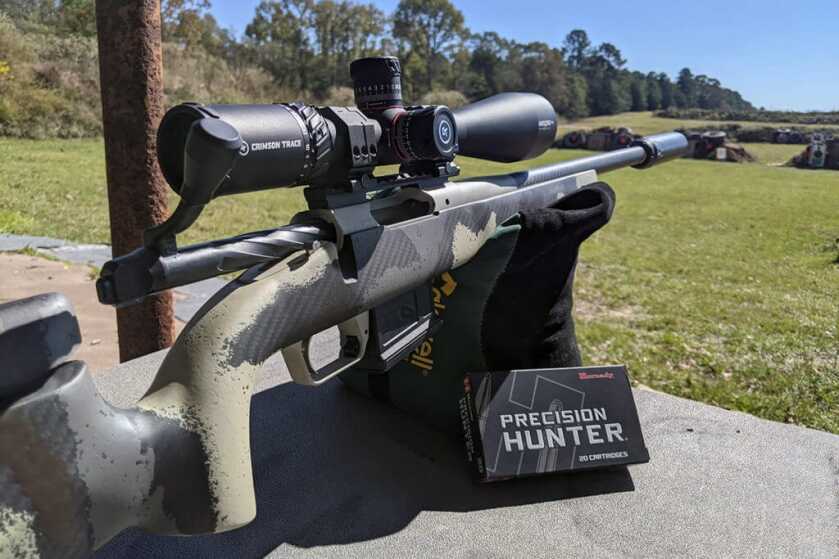
These days, a quality box of 20 hunting or match-grade cartridges can easily cost $80. At $4 per trigger pull, you don’t want to waste any shots sighting in your optic.
That’s why, unless you like setting money on fire, you should use the most efficient sight-in method possible—and you can’t get any more efficient than the two-shot zero.
You can find videos online that claim to “sight-in” rifles with one shot. This is nonsense. You can’t know you’ve made the right scope adjustments until you take your second shot, which is why the two-shot method is the way to go.
Step 1: Choose a Good Scope and Secure It Properly
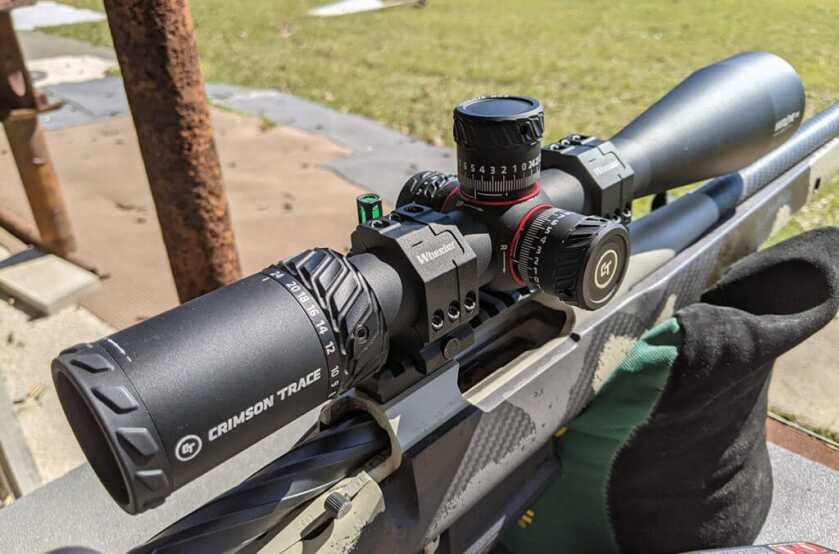
None of this will work if your scope can’t hold zero or you haven’t properly mounted it to your gun.
I chose this 6-24x Crimson Trace Hardline Pro to demonstrate the two-shot zero because I know the CT optic will hold zero, and the turret adjustments will move the reticle exactly where they’re supposed to go. You’ll see the importance of consistent reticle movement in Step 4.
Scope mounting is a multi-step process, but for this 100-yard sight-in, the most important concern is that the rings are tight enough to prevent the scope from moving. For a detailed how-to on scope mounting, click here.
Step 2: Bore Sight the Scope
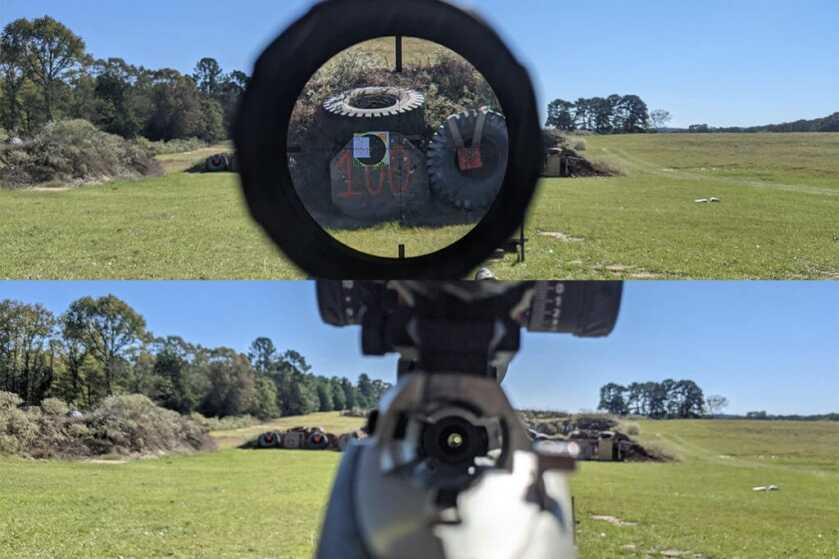
This is the most important step in the entire process. If your scope isn’t properly bore-sighted, you won’t hit paper on the first shot, which will keep you from getting to the bullseye on the second.
You can bore sight a gun one of two ways (generally speaking).
The first is to use a laser bore-sighting kit. These devices can be effective, and they’re a must if you’re bore sighting a lever-action gun or any other firearm that doesn’t allow you to see through the bore. The laser device sits in the muzzle and projects a laser downrange, and the user moves the crosshairs to the point of light.
I don’t have one of these devices, so I prefer to bore sight the old-fashioned way. At 100 yards, you can get on paper just by looking down the barrel.
First, remove the bolt from the gun so you can see through the barrel.
Next, secure the gun in a vise or on sandbags. I used sandbags on this day at the range, but I actually prefer a vice. I like using a vice because I can strap down the gun and ensure it doesn’t move.
Peer down the barrel and move the vice until the center of the paper is in the center of the bore. Take your time with this step! Just because you can see the target through the barrel doesn’t mean the gun is properly aligned. Make sure the bullseye is right in the center.
Finally, without moving the gun, look through the scope and adjust the reticle until it aligns with the bullseye.
Step 3: Take Your First Shot and Measure the Distance to the Bullseye
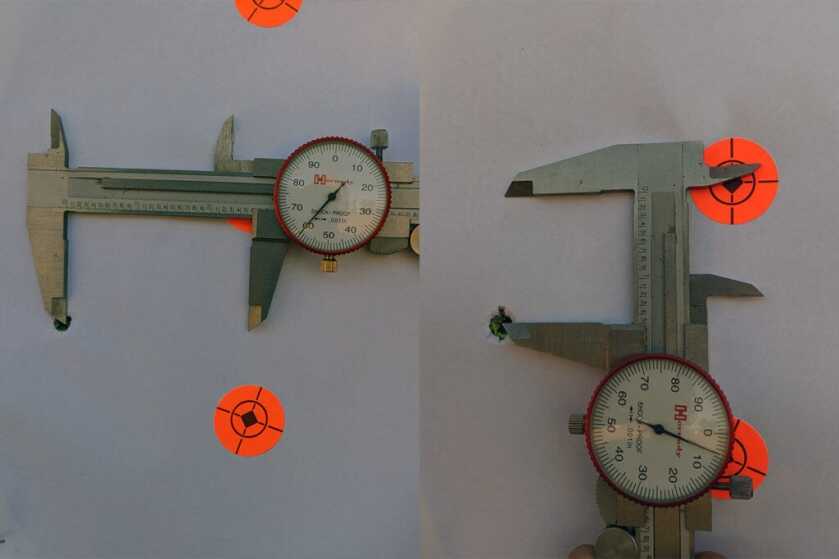
Once you have the rifle back together, take a shot from a vice or from sandbags. Either way, be sure both the front and rear of the gun are stabilized.
I zeroed at 100 yards.
Walk down to your target and measure the horizontal and vertical distance from the point of impact to your bullseye.
Step 4: Determine Scope Adjustments
This step requires a little math. First, determine whether your scope moves the reticle in minute of angle (MOA) or milliradian (MIL) increments.
My Brushline Pro adjusts the reticle in MOA, and one MOA is approximately one inch at 100 yards (it’s actually 1.047”, but who’s counting?). If your scope is in MILs, you can go back to Europe. Just kidding. One MIL at 100 yards is equal to 3.6”.
Adjust the windage and elevation on your scope based on the measurement you took in the previous step. My first shot landed 1.505” low and 1.560” to the left. My scope moves the reticle in 0.25 MOA increments. Therefore, I adjusted my scope 6 clicks “up” (1.5 MOA) and 6 clicks “right” (1.5 MOA).
Step 5: Verify Adjustments with Second Shot
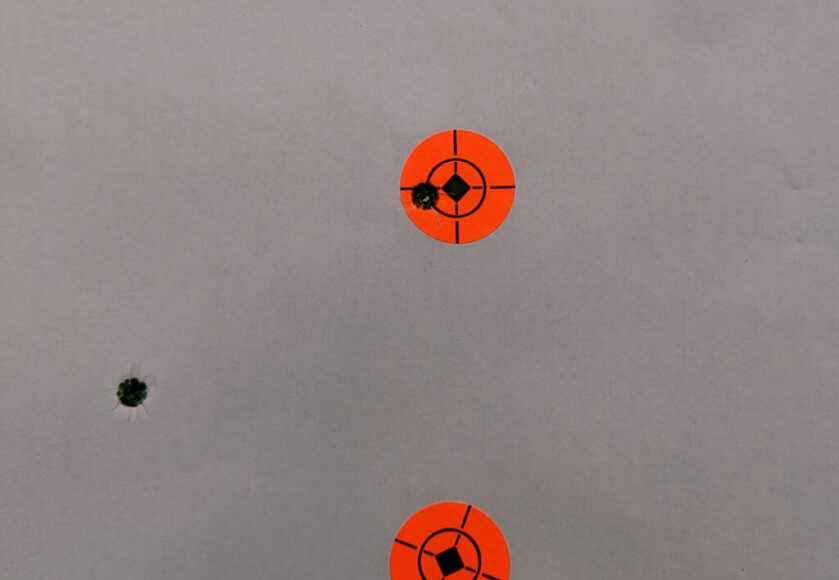
You could call it a day after Step 4. If you only have two cartridges, maybe you should. But if you have more than two rounds, I’d recommend taking a second shot to verify you didn’t accidentally move the reticle “down” instead of “up” or your scope wasn’t jarred loose (not that either of these things have ever happened to me).
Should You Use a Two-Shot Zero?
Now that you know how to zero a rifle in two shots, you should ask yourself: “Should I?”
It depends on how confident you are in that second shot. If you know your rifle is accurate and believe you’ve mounted your scope securely, you’re probably good to go. I know this Springfield Model 2020 is dead nuts accurate, and I’ve been mounting scopes for a long time. If I had continued shooting, I’m confident I would have landed subsequent shots in the bullseye.
But if you’re working with a new rifle or scope, and you have a few extra rounds, it’s a good idea to take a few more shots. A larger group will verify that the second shot wasn’t a fluke and give you confidence that you’ll hit your targets at the next match or on the next hunt.
Whether you use two shots or six shots, the “two-shot zero” method will allow you to get on the bullseye faster, so you can waste fewer shots zeroing your optic and take more shots ringing steel.

Why not just put the scope X on the bullseye, fire two shots, then find the holes, center the scope x on the holes, and the ncrank the scope to be X over the two holes.
having a variety of weapons of different calibers, not to mention scopes, I invested in a boresighter maybe 10 years ago made by a company close to where I live, whose main business is building various electronic laser based gizmos like this for the military. Good investment too. I can set it up in my garage with the target across the street on a block wall 20 yards away & with it’s calculation magic match the dot to the bull equal to 100 yards. When I go out in the desert to check I am always within that inch or two that makes the final adjustment easy.
I have to disagree with the method a bit. You really don’t need to rely on the scope clicks being accurate, or even know what they are, if you are using a super steady rest, as you already did in your bore sighting effort. Simply use that same concept after shot 1, but hold your crosshairs on the bullseye to start, and then adjust the crosshairs to the point of impact of shot 1. It is crucial that your gun doesn’t move during these adjustments. After that, for a hunting rifle, I like to fire at least 3 shots with cooling time in between each, to be sure of where the group center is, and make a final adjustment if necessary. After that, to reconfirm zero prior to hunting season each year, I usually only have to shoot one shot. Ammo is expensive, but wounding game and lacking confidence shouldn’t ever be on the table.
Don’t mean to be too picky but it is a vise, not a vice. A vice is a bad habit.
or a two shot zero
Instead of measuring why don’t you just adjust the scope until the reticle is centered on the point of impact of the first shot. That’s how I used to 2 shot sight in a bow. Then you can eliminate the walk and the measuring also it’s harder to adjust the scope in the wrong direction. 🙂
Never heard the look through the barrel trick. Very cool!
That’s a lot of math and measuring. I’ve done the two-shot zeroing before from a bench (after bore sighting of course) by making the first shot from a bench stable position, then without moving the rifle, adjusting the scope cross hairs to align with the first-round hole in the target. Then moving my sight picture back to bullseye on the target and firing the second shot. Works great. Of course, I usually sight in the way I was trained using 25-meter target.
Mike has the tried and proven scope zero method, and well explained at that. After 70 years using this technique, as taught by my father, I can attest to many successful two shot zeroing sessions. I passed the wisdom to two sons, and they to their sons, and daughters.
I had a shop 30 years or so & sold a lot of heavy recoiling rifles & offered to sight them in for free if I got to keep the rest of the box of ammo. I had a rifle vice & could zero in 1 shot. Shoot the 1st shot, make sure the POA is in the same spot & the vice is tight then move the crosshairs to the hole. I’d shoot a 2nd proof shot & keep 18 rds of high $$ ammo while saving the customer from hamburger shoulder & stop the habit of flinching before it started. Win-Win for all.
I’d skip the whole measurement thing by firing the first shot, locking down the rifle with the crosshairs still on the bullseye, and then adjusting the reticle to coincide with the POI. That works even if the scope adjustment graduations aren’t exactly what it says on the box. You do need a good way to hold the rifle steady as you adjust the scope, but it’s also a two-shot zero that you can do from the firing line.
Every hunting season the benches at the local gun club are full of hunters chasing holes. They fire a single shot from their rifles and start turning dials of which they aren’t sure the right direction or even understand the increments of which the half turns they make…
The combination of rifle, ammunition, and shooter ability give them at best 4 minute capability… They set up on benches in rests thinking it will help them though they do not hunt off benches from their blinds.
A man once bragged to be about a two shot zero. I watched him burn thru a whole box trying to chase that hole.
Typically your cold bore shot is the most important shot with a hunting rifle. It’s kinda hard to know where that is if you don’t fire groups. Or even if it’s consistent.
And these are the same idiots who think they are going on a guided long range hunt to shoot game at 900 yards… like omg rofl….